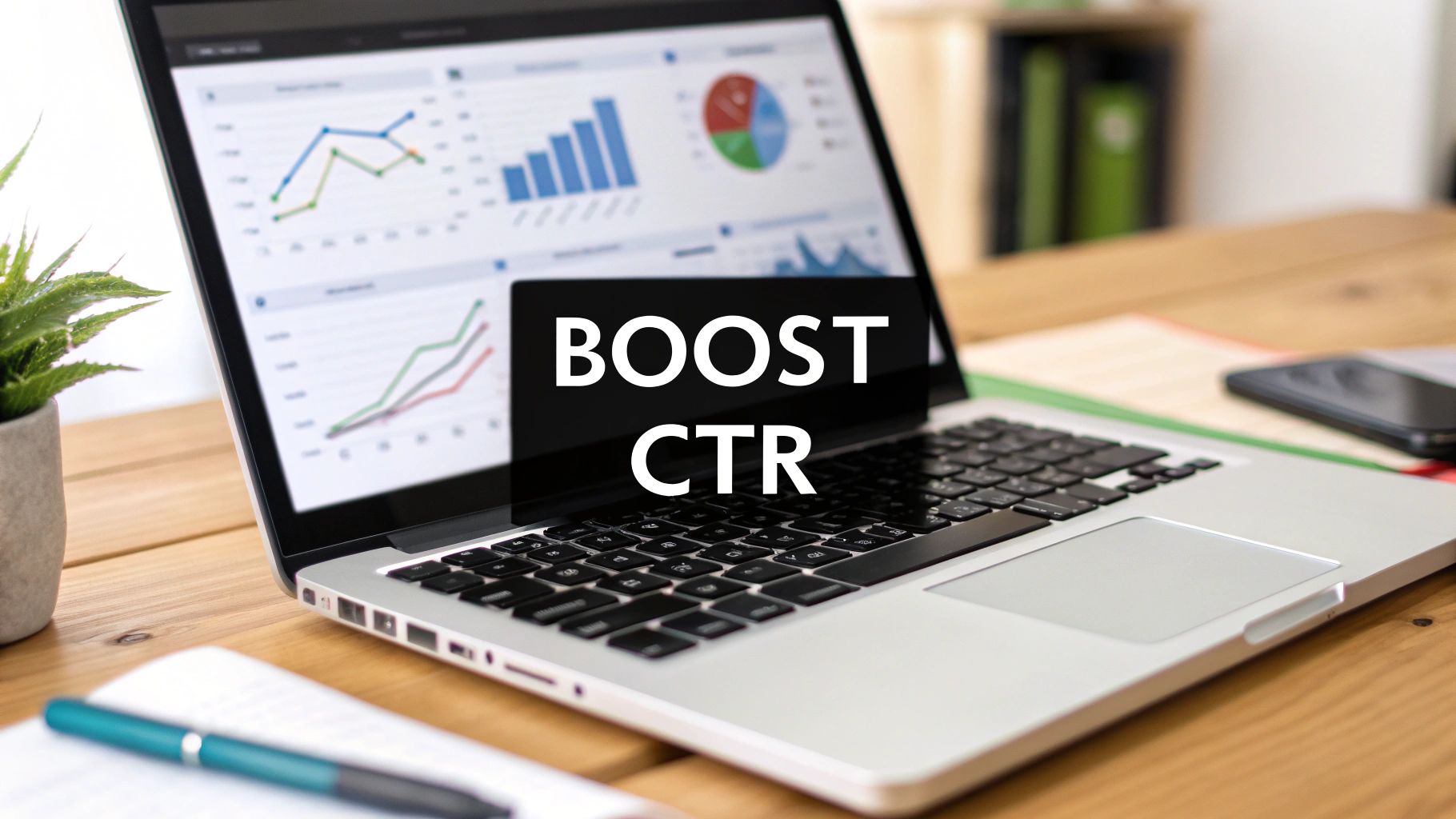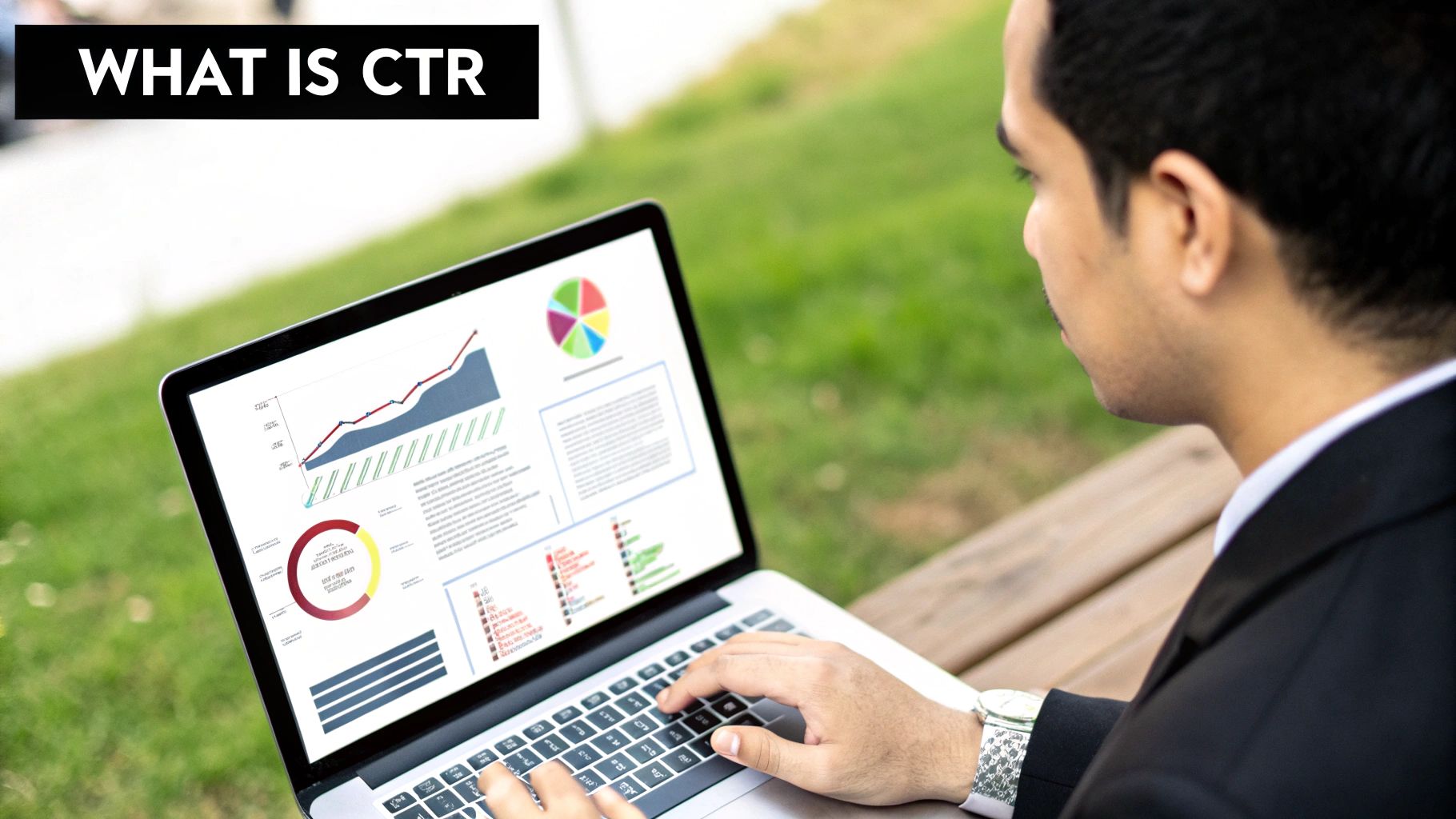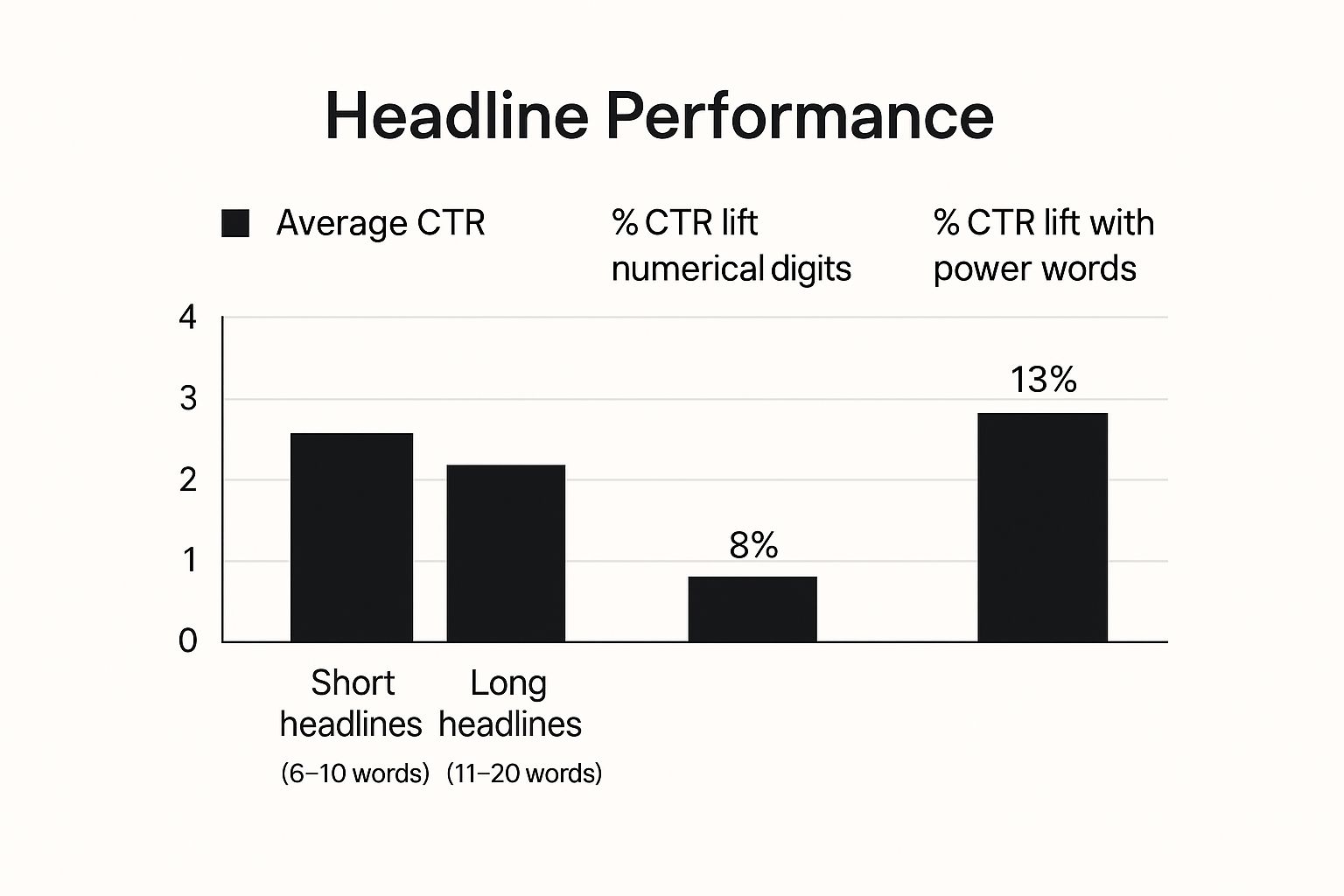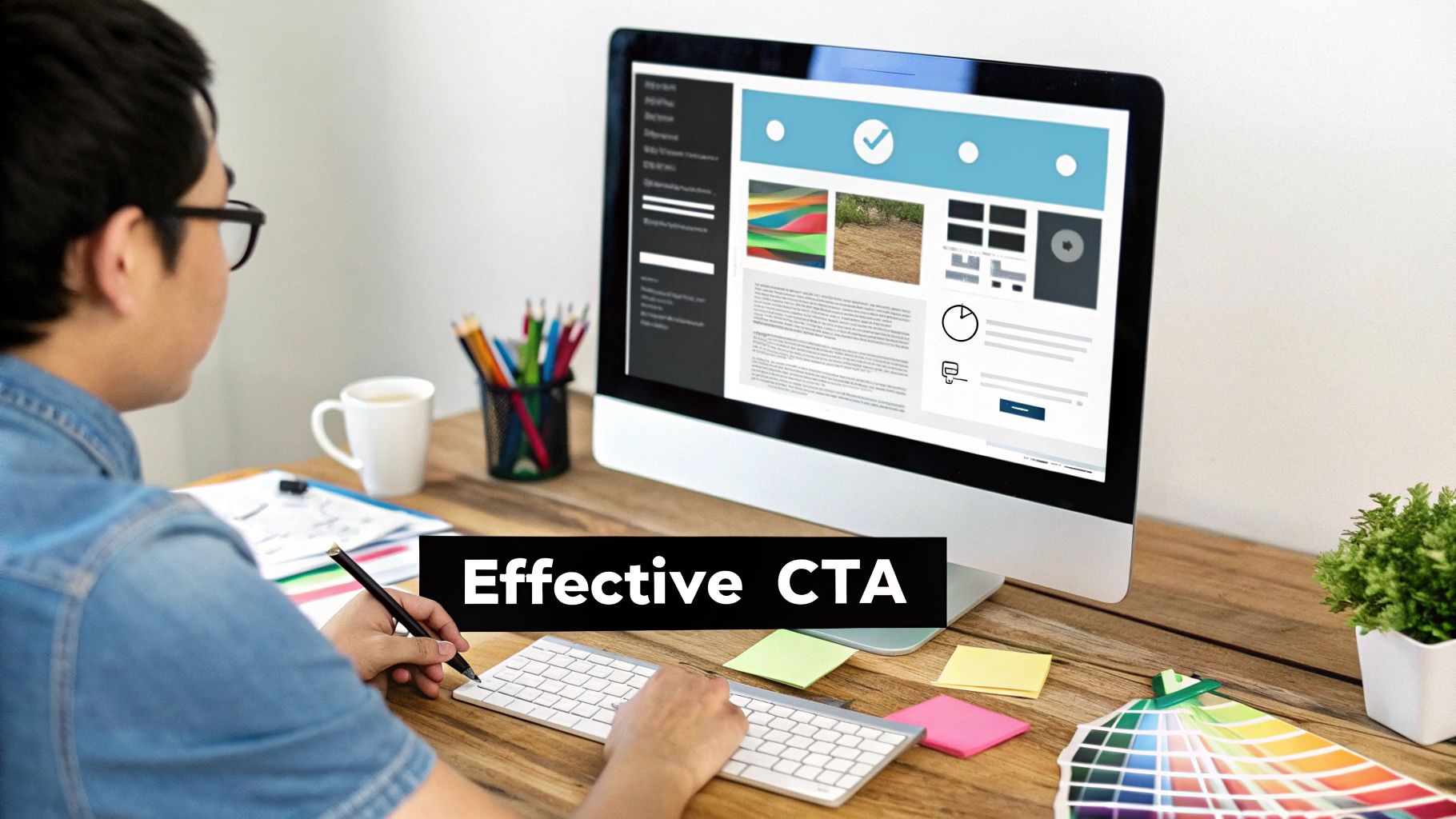
How to Improve Click Through Rates for Better Results
Discover how to improve click through rates with proven strategies. Learn actionable tips for SEO, email, and social media to drive real engagement.
Before you can boost your click-through rates, you have to figure out what's holding them back. It all starts with a simple diagnostic: find your weakest assets and get to the root of the problem.
Dive into your analytics, pinpoint the headlines, ad copy, or subject lines that are falling flat, and then tweak your messaging to better align with what your audience actually wants. This isn't about guesswork; it's about making targeted changes that actually work.
Diagnosing Your Low Click-Through Rates

You can’t fix a problem you don't understand. Before you start A/B testing new button colors or rewriting every headline, you need to play detective. Flying blind leads to wasted time and money, but a data-driven diagnosis points you right to the culprit.
The goal here is to get specific. It’s not enough to know your CTR is low. You need to know why it's low and where it's happening.
Is it one particular ad in your latest Meta campaign? A product category page that racks up impressions on Google but gets almost no clicks? Or that weekly newsletter that consistently gets ignored? Pinpointing these weak spots is the most critical first step.
Start With Your Analytics Foundation
You're probably already sitting on a goldmine of diagnostic data. The key is to dig deeper than the high-level dashboard numbers and find the actionable insights hiding in the tools you already use.
Here’s where to look:
- Google Search Console (GSC): This is ground zero for organic search CTR. Head to the "Performance" report and look for pages with a ton of impressions but a depressingly low average CTR. This is a classic sign that your page is relevant enough for Google to show, but your title tag or meta description just isn't compelling enough to earn the click.
- Email Marketing Platform: Your email provider’s analytics will tell you a story. A high open rate paired with a low click rate is a big clue. It means your subject line worked like a charm, but the email body or call-to-action (CTA) dropped the ball.
- Ad Platforms (Google Ads, Meta Ads): These dashboards offer a granular view of every ad and ad set. Hunt for the outliers—creatives or headlines with CTRs that are tanking compared to others in the same campaign. That tells you exactly which message is missing the mark with your audience.
Of course, to properly diagnose low CTRs and track your improvements, you first need to understand how to measure advertising effectiveness. This provides the right framework for making sense of the data you're collecting.
Identifying Patterns and Problems
Once you've got your data, it's time to connect the dots. A single underperforming asset might just be a fluke, but a recurring issue points to a bigger, systemic problem you can actually solve.
For instance, are all your blog posts on a specific topic getting a poor CTR from search? This might mean there's a disconnect between your content's angle and what people are actually looking for. Maybe your titles are too generic for a keyword that's incredibly competitive.
This same logic applies to social media. If your video ads are consistently outperforming static images, that’s a loud and clear signal about what your audience prefers to engage with. Getting a handle on these trends is crucial, and you can learn more by understanding social media analytics to really decode what the numbers are telling you.
Pro Tip: Stop comparing your CTR to vague industry benchmarks. Your most important benchmark is your own. Calculate your average CTR for blog posts, product pages, and different ad formats. This gives you a much more accurate baseline to spot the real underachievers.
Investigating User Intent Mismatch
One of the most common culprits behind a low CTR is a fundamental mismatch between what someone is searching for and what your headline or ad copy is promising.
Imagine a user types "best running shoes for beginners" into Google. They're clearly in a research and comparison mindset. If your page title is "Buy Nike Running Shoes," you're jumping the gun. It’s too transactional and will likely get skipped over, even if you rank high. A title like "The 5 Best Beginner Running Shoes of 2024" speaks their language and directly addresses their intent.
A great way to diagnose this is to actually look at the SERPs for your target keywords. What kind of language are the top-ranking results using? Are they listicles, how-to guides, or product pages? Aligning your messaging with the dominant intent on the results page is a surefire way to make your content more clickable.
Writing Headlines and Copy That Earn the Click

So, you've figured out where your click-through rates are hurting. Now for the hard part: fixing the why. Nine times out of ten, the problem isn't your targeting or your budget—it's the words you're using.
Think about it. The handful of words in your headline, meta description, or ad copy are the only thing standing between a potential customer and your content. Even the best-ranked article or a perfectly targeted ad will get scrolled past if the copy is dull.
This isn't about writing clickbait. It's about crafting a compelling invitation that’s simply too good to pass up.
The Psychology Behind a Great Headline
Let's be honest, a powerful headline isn't magic. It's psychology. The best ones tap into fundamental human drivers to get that split-second decision to click.
Think about the last article you clicked on without even thinking. Chances are, it made you feel something—curious, understood, or maybe even a little worried about missing out. That's what you need to engineer.
Here’s what makes a headline impossible to ignore:
- Curiosity: We are hardwired to fill knowledge gaps. A headline that teases a solution or hints at an unexpected outcome practically forces a click.
- Benefit-Driven Language: Stop selling features and start selling outcomes. Instead of "Our New AI Writing Tool," try "Write Better Content in Half the Time." The second one speaks directly to what your user actually wants.
- Urgency: Simple phrases like "Limited Time," "Last Chance," or even just dropping the current year ("Best of 2024") create a subtle pressure that encourages people to act now.
- Specificity: Numbers make you sound credible. "How I Increased My CTR by 47%" is way more convincing than "How I Increased My CTR."
This mindset is non-negotiable for social media, too. If you need some inspiration for stopping the scroll, check out these powerful social media hook examples.
Formulas for Crafting Clickable Copy
You don't have to stare at a blank screen every time. Proven formulas give you a solid starting point so you can focus on the message, not the structure.
A classic that never fails is the "How to [Achieve Desired Outcome] Without [Common Pain Point]" formula. For instance, "How to Generate Viral Video Ads Without a Big Budget." It instantly grabs the right audience and crushes a major objection before they can even think it.
Another killer approach is to lead with a question. A headline like, "Are You Making These 5 Common SEO Mistakes?" makes people pause and reflect, creating an immediate need to find the answer.
Key Takeaway: Headlines aren't just titles; they're value propositions. They have one job: to communicate exactly what the user will gain by clicking. Make every single word earn its place.
Numbers and Data in Headlines
There's a reason listicles still dominate search results. Our brains are drawn to numbers. Digits pop out in a sea of text and promise an organized, easy-to-digest piece of content. Time and time again, studies have shown that headlines with numbers just get more clicks.
And here’s a pro tip: odd numbers often outperform even ones. For some reason, "7 Ways to Improve Your Ad Copy" feels more authentic and less manufactured than "10 Ways."
But it’s not just for listicles. Use numbers to show off results and build credibility. A headline like "Case Study: How We Achieved a 300% ROI on TikTok" delivers instant social proof and sets a clear expectation of value.
Knowing the industry benchmarks also gives you a huge advantage. A 2025 analysis from Advanced Web Ranking found that top-position CTR in the Education sector was a massive 45.35%, while the Pets market was just 15.75%. The same study showed that branded searches gave desktop CTRs a 3.08 percentage point lift. This is the kind of data that helps you set realistic goals and write smarter copy.
Tailoring Your Strategy for Different Channels
What makes someone click on a Google search result is a world away from what grabs their attention in a crowded Facebook feed or a packed email inbox. A one-size-fits-all approach to improving your click-through rate just doesn't cut it. To really move the needle, you have to get inside the user's head on each specific platform.
Think about it: On search engines, people are on a mission. On social media, they're passively scrolling for a quick hit of entertainment. In their email, they're on high alert for spam and noise. If you don't adapt your tactics to these different mindsets, you're leaving clicks on the table.
This is where the small details really start to matter, especially in your headlines.

As you can see, simple choices like using numbers or keeping a headline punchy can have a real, measurable impact on whether someone decides to click.
To give you a clearer picture, it's helpful to know what "good" looks like across different platforms.
Average CTR Benchmarks by Channel
This table offers a snapshot of typical click-through rates across major channels, helping you set realistic performance goals.
| Channel | Average CTR | High-Performing Industry Example | High-Performing Industry CTR | | :--- | :--- | :--- | :--- | | Google Search Ads | 3.17% | Arts & Entertainment | 6.05% | | Google Display Ads | 0.46% | Real Estate | 1.08% | | Facebook Ads | 0.90% | Legal | 1.61% | | Email Marketing | 2.00% | Government | 3.99% |
These numbers aren't just trivia; they're your baseline. They tell you where to set expectations and how much a small optimization could be worth.
Winning the Click on Google Search
On a Google results page (SERP), your listing is crammed between a dozen others. Your job isn't just to be there; it's to be the most compelling answer. This is where a few technical tweaks can make all the difference for your organic CTR.
One of the most powerful tools in your arsenal is rich snippets. These are the beefed-up search results with extra info like star ratings, review counts, or pricing. They just pop.
You get them by implementing schema markup, which is essentially code that tells Google what your content is about in its own language. This helps you earn those eye-catching features that can seriously boost your visibility and clicks.
Consider adding these to your pages:
- FAQ Schema: Adds a dropdown of common questions and answers right under your result. It takes up more space on the page and immediately positions you as an expert.
- Review Schema: Displays those little gold stars everyone looks for. A 4.8-star rating is infinitely more clickable than a plain blue link.
- Product Schema: Puts pricing, availability, and an image right on the SERP, giving shoppers the key info they need to make a decision before they even visit your site.
A smart schema strategy does more than just get you clicks—it gets you the right clicks. Someone who clicks on a rich snippet already has more context, which means they're usually more engaged and closer to converting when they land on your page.
Capturing Attention in the Email Inbox
The inbox is an absolute battlefield. A clever subject line might earn the open, but the click happens inside the email. To boost your email CTR, you have to go beyond just using their first name.
The real magic happens when you pair your subject line with the preview text. This tiny snippet of copy is your one-two punch. The subject line sparks curiosity, and the preview text delivers a compelling reason to open and click.
For example:
- Subject Line: Your Weekly Marketing Insights
- Preview Text: 🔥 This week: A case study on doubling ad CTR…
That combo is way more effective than letting the email client pull in the default "View this email in your browser." You're turning dead space into a powerful secondary headline.
Dominating Social Media Feeds
On platforms like Instagram and TikTok, users have the fastest thumbs in the West. Your ad or post has less than a second to stop the scroll. Here, your visuals do all the heavy lifting.
Your copy also needs to feel like it belongs there. Forget the stuffy corporate jargon; it'll get you scrolled past in a heartbeat. Use a conversational tone, sprinkle in some emojis, and format your text like a real person would. This is doubly true for video. If you want a deep dive on creating scroll-stopping ads, our complete guide to Instagram video advertising has you covered.
And when you’re making videos for a platform like YouTube, the thumbnail is practically your entire ad. Picking the best fonts for YouTube thumbnails isn't just a design choice; it's a critical step in earning that click.
Finally, your Call-to-Action (CTA) needs to be crystal clear. Don't be vague. "Shop Now," "Learn More," and "Sign Up" are direct, simple, and effective. Anything else just adds friction and kills your click-through rate.
Using Personalization to Boost Engagement

Let's be honest: generic, one-size-fits-all marketing is now just invisible marketing. Your audience is swimming in a sea of messages every single day. The only ones that actually get noticed are the ones that feel personal.
If you want to earn that click, personalization isn't just a nice-to-have. It’s everything.
The goal is to make your audience feel seen and understood. This goes way beyond just dropping a {{first_name}} tag into a subject line. Real personalization is about using customer data and behavior to create an experience that speaks directly to their needs, right where they are in their journey with you.
Segment Your Email Campaigns for Hyper-Relevance
This all starts with smart segmentation. Instead of blasting the same message to your entire email list, you need to slice it into smaller, more focused groups. This is how you craft campaigns that actually connect with people.
Think about segmenting based on what people do, not just who they are. This simple shift turns a generic newsletter into a genuinely helpful piece of communication someone might actually look forward to.
Here are a few ways I’ve seen this work wonders:
- Past Purchases: Group together everyone who bought a specific camera from you. Next, send them a targeted email showcasing complementary gear like lenses, tripods, or carrying cases.
- Content Downloads: Someone downloaded your "Beginner's Guide to Social Media"? Great. Put them in a segment that gets beginner-level tips, not advanced strategy breakdowns they aren't ready for.
- Website Behavior: Create a segment for users who’ve viewed the same product page three times but haven't bought yet. Send them a gentle nudge with some social proof (like customer reviews) or a small, time-sensitive discount for that specific item.
Build Custom Audiences for Smarter Retargeting Ads
The same logic applies directly to your paid ads, especially retargeting. Showing the exact same ad to every person who has ever visited your website is a huge missed opportunity.
Think of it like picking up a conversation where you left off.
A first-time visitor who only saw your homepage needs a very different ad than someone who ditched a full shopping cart. The cart abandoner is way further down the funnel and needs a much more specific message to entice them back.
When you personalize ad copy for different stages of the customer journey, relevance skyrockets. Someone who knows your brand doesn't need an introduction—they need a compelling reason to come back right now.
Time and again, personalization proves to be one of the most effective levers we can pull. A 2025 case study showed that a company using data segmentation to deliver relevant messages saw a 15.6% jump in CTR. A higher CTR is the ultimate signal that your message is hitting the mark. If you're curious how this plays out across different channels, you can learn more about industry CTR benchmarks.
Use Dynamic Content for a Custom Website Experience
Personalization shouldn't end when someone clicks your ad or email. You can bring that same tailored feel to your website using dynamic content. This means the content on a page can literally change based on who is looking at it.
For example, an e-commerce store could show a different homepage banner to different visitors.
A brand-new visitor coming from a Facebook ad might see: "Welcome! Here's 10% Off Your First Order."
But a loyal, returning customer might see a banner showcasing: "New Arrivals In Your Favorite Categories."
It's a small tweak, but it makes the entire experience feel more relevant from the very first second, encouraging them to click deeper into your site.
Building a Framework for Continuous Improvement
Improving your click-through rate isn't a project you finish. It’s a habit. Think of it as a constant cycle of testing, learning, and tweaking your approach. The moment you get comfortable and stop optimizing is the moment your performance flatlines.
Building a sustainable system isn't about some overly complex process. It’s simply a commitment to making small, data-driven changes over and over again. Instead of throwing spaghetti at the wall or chasing the latest trend, you create a feedback loop where every single campaign teaches you something new about what makes your audience actually click.
This methodical approach turns your marketing from guesswork into a science. You'll stop saying, "I think this will work," and start saying, "I know this works better because the data proves it." That's how you build a real, lasting advantage.
Get into the A/B Testing Mindset
At the heart of any real improvement is A/B testing. It's a simple concept: create two versions of a single asset—an email, an ad, a social post—and show them to different slices of your audience to see which one performs better.
The golden rule? Only change one variable at a time. Seriously. If you change both the headline and the image in an ad, you'll have no clue which change actually moved the needle. A disciplined test isolates one thing so you get a clean, undeniable result.
Here’s what that looks like in the wild:
- Email Subject Lines: Test a question against a statement. Think, "Are you making these marketing mistakes?" versus "Stop making these 5 marketing mistakes."
- Ad Creatives: Run the exact same copy but test a punchy video against a beautiful static image. Which format stops the scroll?
- Meta Descriptions: Keep your title tag the same, but try a benefit-driven meta description ("Get your delivery in 24 hours") against one that's feature-focused ("We offer next-day shipping").
A quick reminder: the goal of A/B testing isn't just about finding a "winner." A losing test is still a massive win if it teaches you something valuable—like your audience prefers a humorous tone over an urgent one.
How to Structure a Test for Clean Data
A badly structured test is worse than no test at all. It can send you sprinting in the wrong direction based on faulty data. To get results you can trust, you need to follow a few simple rules for every experiment.
First, start with a hypothesis. This is just a clear, simple statement you're trying to prove or disprove. For example: "Using an emoji in our email subject line will increase our CTR because it will stand out in a crowded inbox."
Next, let your test run until it reaches statistical significance. Most marketing platforms will tell you when you've hit this mark. It just means you have enough data to be confident the results aren't a fluke. So many marketers make the mistake of ending a test too early because they get excited, only to find the "winner" was just a lucky break.
Finally, document everything. Keep a simple spreadsheet logging your tests, your hypothesis, the variable you tested, the results, and what you learned. This little logbook becomes an invaluable knowledge base over time, preventing you from repeating old mistakes and helping new team members get up to speed in a hurry.
Tracking and Benchmarking for Long-Term Growth
Testing tells you what works right now, but tracking your CTR over the long haul shows you the bigger picture. Are all these small wins actually adding up to sustained improvement?
Set up a simple dashboard to keep an eye on your average CTR across your most important channels.
- Organic Search: Use Google Search Console to track your average CTR for key pages and search queries month-over-month.
- Email Marketing: Monitor your campaign-level CTR, but also keep an eye on your overall list average to see the big trend.
- Paid Ads: Watch both the ad-level and campaign-level CTR to spot what's working and what's starting to fade.
And don't just measure yourself against yourself. While your own progress is what matters most, industry benchmarks give you critical context. Knowing your email CTR is 2.5% feels a lot better when you realize the industry average is hovering around 2%. This helps you set realistic goals and highlights the areas where you have the most room to grow.
Got Questions About CTR? Let's Unpack Them.
Even when you're deep in the trenches of optimization, some questions always seem to pop up. Let's tackle the most common ones I hear, so you can stop wondering and start improving.
Think of this as your quick-reference guide for those nagging questions that can bring your progress to a screeching halt. Getting these fundamentals right is key to confidently testing and tweaking your campaigns.
What Is a Good CTR Anyway?
This is the million-dollar question, and the honest answer is: it completely depends on the channel and your industry.
A "good" CTR for a Google search ad targeting your own brand name could be 30% or higher. On the other hand, a good CTR for a display ad hitting a cold audience might be a humble 0.5%. They're both "good" in their own context.
Instead of chasing some mythical universal number, focus on beating your own benchmarks. A recent survey of over 130 marketers showed that almost half see an average organic search CTR between 3-5%. Use that as a loose reference point, but your real goal should always be to outperform your last campaign.
How Long Should I Run an A/B Test?
I know it's tempting to call a winner after just a day or two, but that's a huge mistake. You have to let a test run long enough to reach statistical significance. This just means the results are solid and not some random fluke.
Most ad and email platforms will actually tell you when you've hit this mark. As a rule of thumb, shoot for at least 1,000 impressions or recipients for each version of your test. Let it run for at least a full week to smooth out any weird daily spikes or dips in user behavior.
Key Insight: Remember, a "losing" test is still a win if you learn something. If Version B totally bombed, you've just discovered what doesn't work for your audience. That's just as valuable as finding out what does.
Why Is My CTR High but My Conversions Are Low?
Ah, the classic sign of a message mismatch. This happens when your ad or headline does a fantastic job of getting the click, but the landing page doesn't deliver on that initial promise. The user feels tricked, gets confused, and bounces immediately.
Imagine your ad screams, "50% Off All Winter Coats," but the link dumps them on your homepage, forcing them to hunt for the sale. You've just broken their trust. Your landing page needs to feel like a seamless next step from the ad. A high CTR proves your hook is working; now you just have to nail the follow-through.
What's the Easiest Quick Fix for a Low CTR?
If you need a fast win, start with your headlines and title tags. This is almost always the lowest-hanging fruit.
Jump into your Google Search Console and find a page that's getting plenty of impressions but has a sad, below-average CTR.
Try one of these simple tweaks to the title tag:
- Add the current year (e.g., "Best Marketing Tools of 2024")
- Use brackets to add context (e.g., "[Case Study]")
- Frame it as a question (e.g., "How Do You...?").
- Add a specific number ("7 Ways to...")
This single change is often enough to create a noticeable lift in just a few weeks, no major overhaul required.
Ready to stop guessing and start creating? ViewPrinter gives you the AI-powered tools to generate viral social media content, from stunning visuals to compelling copy, all in one platform. Streamline your entire workflow and drive the clicks that matter. Create your first viral video with ViewPrinter today.